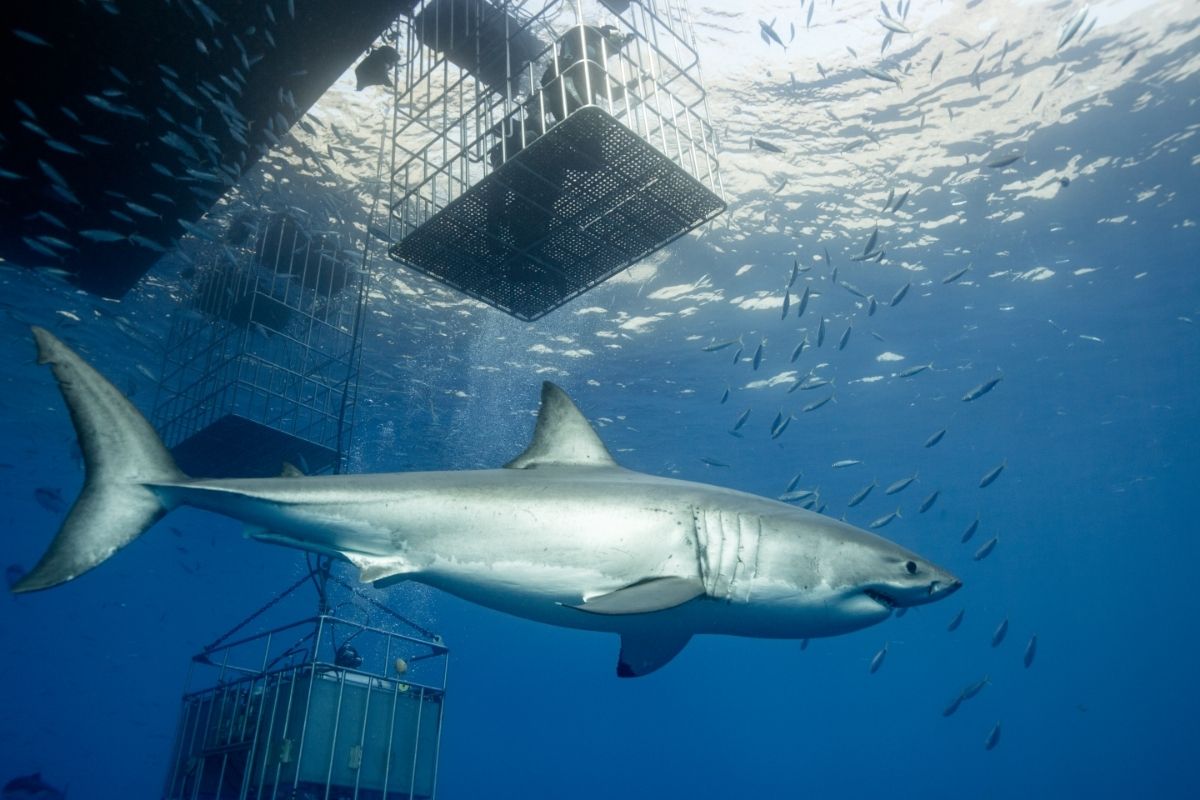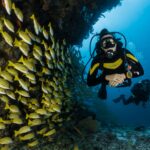Whilst shark cage diving might seem like a terrifying prospect to some, to others it can be an exhilarating activity that has become more popular than ever in recent years.
However, due to the extreme nature of the sport, it is important to ensure that you have done as much research as possible before you embark on a cage diving expedition.

With this in mind, we will be compiling everything you need to know about shark cage diving into one handy guide that should help you on your way to getting the most out of your experience and finding the options that suit you best.
Let’s get started.
What is Shark Cage Diving?
Shark cage diving refers to an activity wherein- through the use of a shark-proof cage- people are able to observe sharks via snorkeling or diving underwater.
This is an activity that has become more popular for tourists to engage in, but it was previously used for scientific observation purposes as well as for underwater cinematography.
The cages that are used are similar to those that tend to be used as protection for divers that work within waters where sharks are prominent.
Different shark cage diving experiences offer slight variations, though there is generally no need for scuba diving experience.
Where Can I Go Cage Diving?
There are certain places that offer the best level of professionalism and experience when it comes to shark cage diving. Let’s take a look at a few noteworthy places that you can go to experience this underwater activity.
The Western Cape, South Africa
The southwestern Cape of South Africa is well known for its shark-filled waters, particularly the 200-mile-long coastline which runs from Mossel Bay to Gansbaai.
This area is known for its great white shark population as well as its bronze whaler sharks. The sharks in this area are so prominent that the coastline between the two territories is known as the “white shark world capital”.
This dense shark population stems from the Cape fur seals that reside five miles offshore from Gansbaai on Dyer Island.
Being a well-known and favored food source for sharks, this seal population is one of the major reasons that the Western Cape has such a large and established shark population.
However, unpleasant- and sometimes fatal- encounters with orcas have driven the sharks in the area into deeper waters, particularly the great whites.
Bronze whalers are now the most common that are seen inhabiting this area.
When it comes to the shark cage diving experience in the Western Cape, operators will cover a wide portion of the area by running trips out of False Bay, Mossel Bay, and Gansaabi.
Farallon Islands, United States
The Farallon Islands- a National Marine Sanctuary- can be found not too far from the Golden Gate Bridge of San Francisco and much like The Western Cape, it is the seal population within the sanctuary that attracts tons of great white sharks to the area between the months of July and January on a yearly basis.
These numbers tend to vary from as low as 30 to as many as 100 sharks descending on the area.
As this area tends to be focused around a certain season, there are windows of opportunity that can be taken to visit the islands and dive with the sharks.
The operators of the diving activities tend to run expeditions concurrently with the hunting season- late September to late November- to attract the maximum amount of sharks.
One positive feature of the cage diving tours held on the Farallon Islands is that they utilize a certain kind of bait to attract the attention of sharks.
Many cage diving activities will use chum- ground up fish parts- to do so, but this can have an environmental impact due to the unnatural feeding process.
Instead, mammal-shaped decoys are used rather than actual food so as not to disrupt the natural feeding order of the sharks.
There is also much effort put into undertaking cage diving in an ethical and sustainable manner, allowing the sharks to remain as free from disturbance as possible.
Isla Guadalupe, Mexico
If you are looking for an intense and memorable shark cage diving experience, Isla Guadalupe is the perfect place for you.
Considered to be the best place to dive with great whites, Isla Guadalupe is a volcanic island that is uninhabited, found around 150 miles off of the Baja California Pensisula.
The only way that visitors are able to get to the island is on a liveaboard and this is where various boats offer the opportunity for shark cage diving.
There are a few different times that you are able to visit to give cage driving a try at Isla Guadalupe.
The main season of the great white sharks lasts from around July through to November, but large males can be seen from September onwards.
When the weather gets cooler in October, large females become more prominent, so this is also a time where it is possible to visit.
The island is unique in that it is the only place that utilizes a self propelled ocean cage (or SPOC). SPOC’s are submerisbles and they offer a different experience in that they allow the divers to cruise alongside the sharks at the speed of 5 knots.
This unique nature and beautiful location creates a shark cage experience that is truly remarkable.
These are just a few of the best places to check out shark cage diving, with some other noteworthy locations including O’ahu in Hawaii, Neptune Islands in Australia , Tiger Beach in the Bahamas and the Crystal Coast in North Carolina.

Important Tips to Remember With Shark Cage Diving
There are various points that it is important to keep in mind if you are planning on going shark cage diving. Lets take a look at a few of these key points.
Research Different Tours
This is especially important if you are new to shark cage diving, as there are various companies that offer different sorts of tours and experiences.
As mentioned when we looked at some of the experiences above, different parts of the world will be better to visit at certain times when the sharks are most active.
If you are planning on travelling with a friend or family member who isnt quite as keen on coming face to face with a shark, have a look around at experiences that also have different kinds of activities to offer to keep them occupied.
Pack the Essentials
The company that you opt for will provide the technical gear that will be needed, but there are a few things that you can bring with you to prepare yourself as best as possible, such as the following:
- Appropriate clothing for in between dives (make sure you take into account the weather in that location and the time of year to do this).
- Spare clothes .
- An exposure suit that will be suitable for the water temperature of your destination as well as one that is suitable for wear for long periods of time whilst submerged in water.
- Motion sickness medication if you suffer from motion sickness due to the choppy nature of the ocean, the unpredictability of the waves and the exaggerated movement of the cage when underwater.
- Food and water to stay hydrated and keep warm whilst in and out of the water for long periods of times. If you suffer from motion sickenss, try to bring plain food in case of any issues.
- A camera or GoPro, but make sure to keep them close to your person when inside the cage and only use them with the go ahead from the organisers of the dive. Otherwise, you could risk a shark causing some serious damane to your expensive equipment due to their ability to detect small electric fields.
Always Follow the Rules
To avoid any potentially dangerous incidents, make sure that you abide the rules at all times from the organisers of the dive. Cage diving is a safe and fascinating experience, but accidents can always happen.
Maintain space between yourself and the rim of the cage and keep your hands, feet and all other body parts inside of the cage at all times!
If you ever find yourself uncertain of what to do, have a thorough conversation with the organisers to ensure that you are all on the same page.
Follow the protocol, be mindful, cautious and aware of your surroundings and you are sure to have a memorable and safe experience.
Frequently Asked Questions
Is Shark Cage Diving Safe?
It is completely natural to feel worried about your safety when it comes to an activity such as shark cage diving.
However, this is an activity that is safe so long as you approach it with a respectful and responsible attitude.
There are certain regulations put in place in most locations that offer cage diving, such as the Code of Conduct and Regulations set up by the Marine and Coastal Management Department of Environmental Affairs and Tourism in South Africa.
As long as you are sensible then you should have no problem in terms of safety.
Is Shark Cage Diving Environmentally Friendly?
There are certain ways to go about cage diving that make less of an impact on the natural order of things, such as the decoy bait we mentioned earlier which is preferable to the chum option.
Many organisations will try to keep things as environmentally friendly as possible but if you have any questions, make sure to ask them upfront.
Is There a Time That is Best to See Sharks?
This varies from country to country, but in most cases there are certain times of the year that are the most appropriate to see the most sharks.
For example, in South Africa there are two main shark seasons: January and February and then August and September.
These seasons would be the best time for you to undertake some cage diving, as it means that there will be plenty of sharks around for your experience.
This is another topic that you’ll need to research before you book your trip!
Final Thoughts
There are tons of memorable experiences to be had with an activity such as shark cage diving, but the intense nature of the activity as a whole means that it isn’t going to be for everyone.
If you decide that you definitely want to give shark cage diving a try, make sure that you do your research thoroughly beforehand and take into account the various factors that we have listed above to ensure that you get the most of your experience.
- Is It Possible For A Shark To Swim Backwards? - August 2, 2024
- Are Leopard Sharks Dangerous? - August 2, 2024
- What Are The Differences Between Shark And Dolphin Fins? - August 1, 2024








